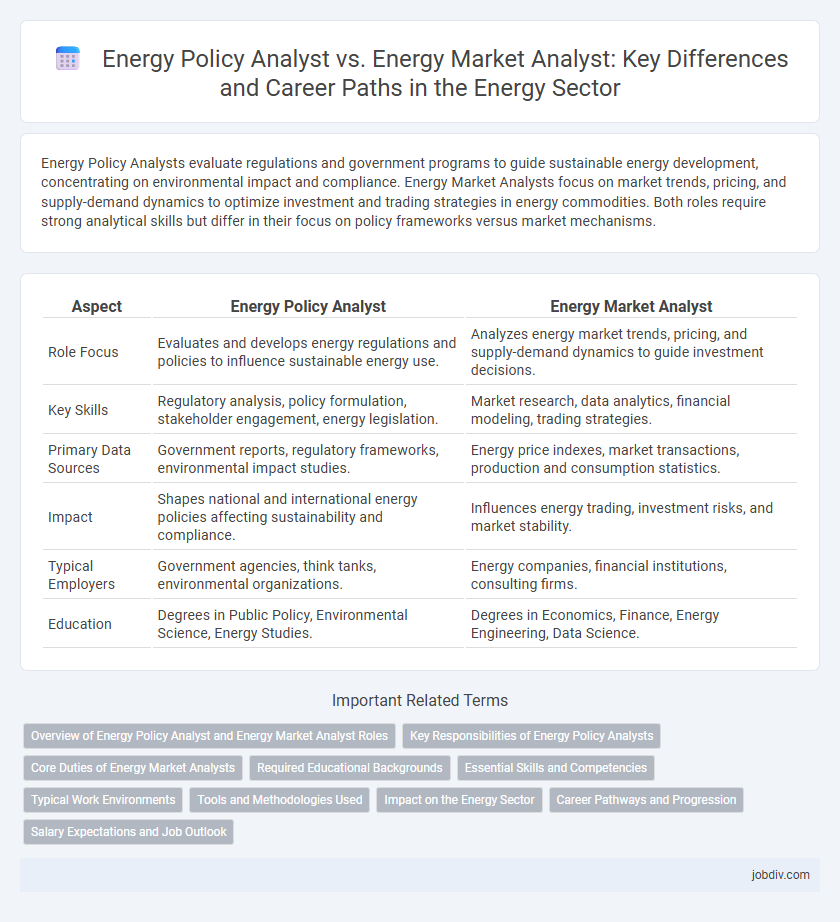Energy Policy Analysts evaluate regulations and government programs to guide sustainable energy development, concentrating on environmental impact and compliance. Energy Market Analysts focus on market trends, pricing, and supply-demand dynamics to optimize investment and trading strategies in energy commodities. Both roles require strong analytical skills but differ in their focus on policy frameworks versus market mechanisms.
Table of Comparison
| Aspect | Energy Policy Analyst | Energy Market Analyst |
|---|---|---|
| Role Focus | Evaluates and develops energy regulations and policies to influence sustainable energy use. | Analyzes energy market trends, pricing, and supply-demand dynamics to guide investment decisions. |
| Key Skills | Regulatory analysis, policy formulation, stakeholder engagement, energy legislation. | Market research, data analytics, financial modeling, trading strategies. |
| Primary Data Sources | Government reports, regulatory frameworks, environmental impact studies. | Energy price indexes, market transactions, production and consumption statistics. |
| Impact | Shapes national and international energy policies affecting sustainability and compliance. | Influences energy trading, investment risks, and market stability. |
| Typical Employers | Government agencies, think tanks, environmental organizations. | Energy companies, financial institutions, consulting firms. |
| Education | Degrees in Public Policy, Environmental Science, Energy Studies. | Degrees in Economics, Finance, Energy Engineering, Data Science. |
Overview of Energy Policy Analyst and Energy Market Analyst Roles
Energy Policy Analysts evaluate regulatory frameworks, government policies, and environmental impacts to guide sustainable energy development and compliance. Energy Market Analysts focus on market trends, pricing strategies, and supply-demand dynamics to optimize energy trading and investment decisions. Both roles require expertise in energy economics, data analysis, and industry regulations but differ in strategic emphasis on policy formulation versus market performance.
Key Responsibilities of Energy Policy Analysts
Energy Policy Analysts conduct thorough research on regulatory frameworks, evaluate the impact of government policies on energy sectors, and provide recommendations to shape sustainable and efficient energy strategies. They analyze legislative trends, assess environmental implications, and model policy outcomes to influence decision-making processes at local, national, and international levels. Their role involves collaborating with stakeholders, drafting policy reports, and monitoring compliance to support energy transition goals and regulatory adherence.
Core Duties of Energy Market Analysts
Energy Market Analysts specialize in evaluating market trends, supply and demand dynamics, and price fluctuations within the energy sector to inform trading strategies and investment decisions. Their core duties include conducting quantitative analyses, monitoring regulatory impacts, and forecasting energy prices using statistical models and market data. They collaborate closely with traders, policymakers, and financial institutions to optimize market performance and assess risks.
Required Educational Backgrounds
Energy Policy Analysts typically require a master's degree in public policy, environmental science, or energy economics, emphasizing regulatory frameworks and policy impact analysis. Energy Market Analysts often hold degrees in finance, economics, or engineering, focusing on market trends, pricing models, and energy trading systems. Both roles benefit from specialized certifications such as the Certified Energy Manager (CEM) or Energy Risk Professional (ERP) to enhance technical expertise and industry credibility.
Essential Skills and Competencies
Energy Policy Analysts require strong skills in regulatory analysis, policy development, and economic impact assessment to evaluate and influence energy regulations and legislation effectively. Energy Market Analysts focus on competencies in market trend analysis, data modeling, and financial forecasting to assess energy supply, demand, and pricing dynamics. Both roles necessitate expertise in energy systems, analytical thinking, and proficiency in data interpretation, but their emphasis diverges between policy implications and market performance.
Typical Work Environments
Energy Policy Analysts typically work in government agencies, research institutions, and non-profit organizations where they focus on regulatory frameworks, policy development, and impact assessments. Energy Market Analysts are commonly employed by utility companies, financial institutions, and energy trading firms, analyzing market trends, pricing data, and supply-demand dynamics. Both roles require strong analytical skills but differ in their primary environments, with Policy Analysts emphasizing policy and regulation, while Market Analysts concentrate on market performance and forecasting.
Tools and Methodologies Used
Energy Policy Analysts utilize qualitative research methods, policy analysis frameworks, and modeling software such as LEAP (Long-range Energy Alternatives Planning) to assess regulatory impacts and guide sustainable energy initiatives. Energy Market Analysts focus on quantitative tools including econometric models, real-time data analytics platforms like Bloomberg Terminal, and market simulation software to forecast energy prices and market trends. Both roles employ Geographic Information Systems (GIS) and scenario analysis but tailor their methodologies to policy evaluation versus market dynamics assessment.
Impact on the Energy Sector
Energy Policy Analysts shape regulatory frameworks and influence legislation that drives sustainable energy initiatives, impacting long-term sector growth and environmental compliance. Energy Market Analysts provide critical insights on energy pricing, demand trends, and market dynamics, enabling strategic investments and operational efficiency within the energy sector. Both roles are pivotal in steering the energy industry towards resilience and innovation amid evolving global energy challenges.
Career Pathways and Progression
Energy Policy Analysts typically advance by specializing in regulatory frameworks and public policy development, often moving into senior advisory or governmental roles. Energy Market Analysts focus on forecasting market trends and pricing strategies, progressing towards positions in trading, risk management, or strategic planning within energy corporations. Both career pathways offer growth through increased expertise in renewable energy integration, regulatory compliance, and economic analysis of energy systems.
Salary Expectations and Job Outlook
Energy Policy Analysts typically earn between $65,000 and $90,000 annually, focusing on government regulations and policy impacts, while Energy Market Analysts command salaries ranging from $70,000 to $95,000, concentrating on market trends and pricing strategies. The job outlook for Energy Policy Analysts shows steady growth fueled by increased regulatory emphasis on renewable energy, whereas Energy Market Analysts experience faster growth driven by dynamic market demands and technological advancements. Both roles require strong analytical skills, but Energy Market Analysts often benefit from higher salary potential due to their direct impact on investment and trading decisions.
Energy Policy Analyst vs Energy Market Analyst Infographic

 jobdiv.com
jobdiv.com